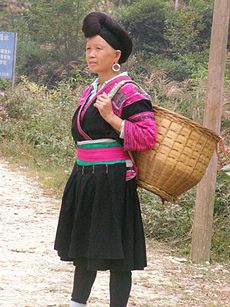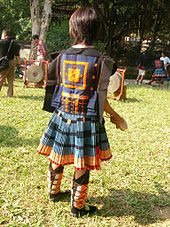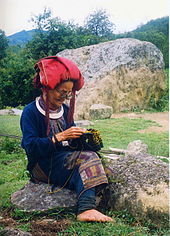- Yao people
-
This article is about the Yao ethnic group in Asia. For the Yao people of Africa, see waYao.
Yao people
瑶族
A Yao woman Total population 3,100,000 Regions with significant populations  China
China
 Vietnam
Vietnam
 Laos
Laos
 Thailand
ThailandLanguages Mienic languages, Lakkja language, Chinese, Vietnamese, Mandarin Chinese
Religion The Yao nationality (its great majority branch is also known as Mien; Traditional Chinese: 瑤族, Simplified Chinese: 瑶族, Pinyin: Yáo zú; Vietnamese: người Dao) is a government classification for various minorities in China. They form one of the 55 ethnic minority groups officially recognized by the People's Republic of China, where they reside in the mountainous terrain of the southwest and south. They also form one of the 54 ethnic groups officially recognized by Vietnam. In the last census in 2000, they numbered 2,637,421 in China, and roughly 470,000 in Vietnam.
Yao people Chinese 瑶族 Transcriptions Hakka - Romanization Yâu-tshu̍k Min - Hokkien POJ Iâu-cho̍k - Min-dong BUC Ièu-cŭk - Teochew Peng'im Iêu-tsôk Wu - Romanization yau zoh Contents
History
Early history
Origins of the Yao, Iu-Mien can be traced back 2,000 years ago, starting in Hunan Province.
The Yao people were among the rebels during the Miao Rebellions (Ming Dynasty), along with the Miao people against the Ming dynasty.
Around 1890 the Guangdong government started taking action against Yao in northwestern Guangdong.[1]
Emigration
From the late 1800s to early 19th century, the Yao migrated into Thailand, Vietnam and the highlands of Laos. The migration was agitated by the opium trade said by the Chinese government. But The Iu Mien say all the emigration was because of the Chinese taking their land.
Laotian Civil War
During the Laotian Civil War, Yao tribes of Laos had a good relationship with U.S. forces and were dubbed to be an “efficient friendly force.”[2] This relationship caused the Laotian government to target Yao tribal groups for revenge once the war was over. This triggered further immigration into Thailand, where the tribes would be put into camps along the Thailand-Laos border.
Immigration to the United States
After obtaining refugee status from the Thai government and with the help of the United Nations, many Yao people were able to obtain sponsorship into the United States (although many remain in Thailand). Most of the Yao who have immigrated to the United States have settled along the Western part of the U.S., mainly in Northern California such as Visalia, Fresno, Oakland, Oroville, Redding, Richmond, Sacramento, but also in parts of Oregon Portland, Salem, Beaverton and the state of Washington Seattle, Renton, . See Mien American for those identified as Mien.
Culture
The typical houses of the Yao are rectangular and they have structures made of wood and bamboo. Normally it has three rooms: a room and two dormitories in the lateral side. Each one of these rooms has a small oven to cook.
The men and the women cover their heads with a black or red scarf. Some women substitute this scarf by a turban that can adopt different forms.
The traditional suit of the women is of bright colors. They also decorate their shirts with decorations made out of silver.
In Vietnam, Yao people celebrate many exciting and meaningful festivals such as Nhơn chung lỉnh (literally: Red rice, Green rice"), Nhiang chằm đao (literally: Jumping Festival).
Religion
The Yao, Iu-Mien, have a religion based on medieval Chinese (Taoism), although many have converted to Buddhism and some to Christianity. Though some people have converted to other religions, many still remained practicing their traditions.
Marriage
Marriage is traditionally arranged by go-betweens who represent the boy's family to the girl's parents. If the union is acceptable, a "Bride" price is negotiated, typically ranging from three to ten silver bars, worth about $100 U.S. dollars each, a partial artifact from the opium trade. The wedding takes place in two installments, first at the bride's house, followed by a procession to the groom's house where a second ceremony occurs.
Groups and languages
There are several distinct groups within the Yao nationality, and they speak several different languages, The Iu Mien makes up 70% of the Yao Nationality, different language families: Cenuses taken on 2000
- Miao–Yao languages
- The Mien speak Mienic languages (Chinese: Miǎnyǔ, Traditional Chinese: 勉語, Simplified Chinese: 勉语) , including:
- Lakkja language (a Tai–Kadai language)
- Chinese
- about 500,000 Yao speak Chinese dialects
In addition to China, populations of Yao also live in Northern Vietnam (where they are called Dao), Northern Laos, and Burma. There are around 60,000 Yao in Northern Thailand, where they are one of the six main hill tribes. The lowland-living Lanten of Laos, who speak Kim Mun, and the highland-living Iu Mien of Laos are two different Yao groups. There are also many Yao living in the United States, mainly refugees from the highlands of Laos who speak the Iu Mien language. The Iu Mien do not call themselves "Yao". Not all "Yao" are Iu Mien.
A group of 61,000 people on the island of Hainan speak the Yao language Kim Mun 139,000 speakers of Kim Mun live in other parts of China (Yunnan and Guangxi), and 174,500 live in Laos and Vietnam.[6]
The Bunu call themselves Nuox [no˩˧], Buod nuox [po˦˧no˩˧], Dungb nuox [tuŋ˧no˩˧], or their official name Yaof zuf [ʑau˨˩su˨˩]. Only 258,000 of the 439,000 people categorised as Bunu in the 1982 census speak Bunu; 100,000 speak Zhuang, and 181,000 speak Chinese and Bouyei.
Written languages
After the Eleventh Plenary Session of the Eleventh Central Committee of the Communist Party of China, the Guangxi Nationality Institute and the Chinese Academy of Social Sciences together created a new Yao writing system which was unified with the research results of the Yao-American scholar Yuēsè Hòu (Traditional Chinese: 約瑟·候/Simplified Chinese: 约瑟·候). The writing system was finalized at a one-day conference in 1984 in Ruyan County, Guangdong, which included Chinese professors Pan Chengqian (盤承乾/盘承乾), Deng Fanggui (鄧方貴/邓方贵), Liu Baoyuan (劉保元/刘保元), Su Defu (蘇德富/苏德富) and Yauz Mengh Borngh; Chinese government officials; Mien Americans Sengfo Chao (Zhao Fuming), Kao Chiem Chao (Zhao Youcai), and Chua Meng Chao; David T. LeeUnited States Linguist Herbert C. Purnell, who developed a curriculum and workshop presentations on language learning in East and Southeast Asia; and Yao Seng Deng from Thailand. The US delegation took the new writing system to the Iu Mien community in the United States where it was adopted with a vote of 78 to 7 by a conference of Mien American community leaders.[7] This writing system based on the Latin alphabet was designed to be pan-dialectal; it distinguishes 30 syllable initials, 121 syllable finals and eight tones.
For an example of how the unified alphabet is used to write Iu Mien, a common Yao language, see Iu Mien language.
There is a separate written standard for Bunu, since it is from the Hmong/Miao side, rather than the Mien/Yao side, of the Miao–Yao language family.
A variety of Yao is, or was, written in Nüshu, an indigenous script.
Officially illiteracy and semi-literacy among the Yao in China still stands at 40.6%, as of 2002.[8]
References and sources
 This article incorporates text from The Chinese times, Volume 4, a publication from 1890 now in the public domain in the United States.
This article incorporates text from The Chinese times, Volume 4, a publication from 1890 now in the public domain in the United States.
- ^ The Chinese times, Volume 4. TIENTSIN: THE TIENTSIN PRINTING CO.. 1890. p. 24. http://books.google.com/books?id=eRI-AQAAIAAJ&pg=PA24&dq=the+most+capable+and+energetic+of+them+were+doubtless+able+to+the+conditions+of+entrance+into+the+chinese+army,&hl=en&ei=1OQITp27KZC_gQeBuKWXCg&sa=X&oi=book_result&ct=result&resnum=1&ved=0CCoQ6AEwAA#v=onepage&q&f=false. Retrieved 2011-06-27.From January, 1890, to December, 1890 (STANFORD LIBRARY)
- ^ Independent Lens . DEATH OF A SHAMAN . The Mien | PBS
- Máo Zōngwǔ 毛宗武: Yáozú Miǎnyǔ fāngyán yánjiū 瑶族勉语方言研究 (Studies in Mien dialects of the Miao nationality; Běijīng 北京, Mínzú chūbǎnshè 民族出版社 2004), ISBN 7-105-06669-5.
- Méng Cháojí 蒙朝吉: Hàn-Yáo cídiǎn - Bùnǔyǔ 汉瑶词典——布努语 (Chinese-Yao Dictionary - Bunu; Chéngdū 成都, Sìchuān mínzú chūbǎnshè 四川民族出版社 1996), ISBN 7-5409-1745-8.
- Barker, Judith C., and Saechao, Kaochoy. "A Household Survey of Older Iu-Mien Refugees in Rural California." Journal of Cross-Cultural Gerontology 12.2 (1997): 121-143.
- Barker, Judith C. & Saechao, Kaochoy. (2000). A demographic survey of Iu-Mien in West Coast States of the U.S., 1993. Journal of Immigrant Health, 2:1, 31-42.
Films
- 2003 - Death of a Shaman. Directed by Richard Hall; produced by Fahm Fong Saeyang.
- 1989 - "Moving Mountains: The Story of the Yiu Mien". Directed and produced by Elaine Velazquez
External links
- The Virtual Hilltribe Museum
- The Yao ethnic minority (on a Chinese government website)
- Yao religious culture - bibliography by Barend ter Haar
- Yao People On-line - in Chinese
- The Mien
- The Yao of Thailand
See also
East South Central Southwest North Northeast Northwest Nationwide Government-classified ethnic groups in Burma (Myanmar) Kachin (12) Kayah (9) Kayah (Karenni) · Pale · Zayein · Ka-Yun (Kayan; Padaung) · Manu Manaw · Gheko · Yin Talai · Yin Baw · Kayinpyu (Geba Karen)Karen (11) Kayin (Karen) · Pa-Le-Chi · Mon Kayin (Sarpyu) · S'gaw · Ta-Hlay-Pwa · Paku · Bwe · Monpwa · Monnepwa · Shu (Pwo)Chin (53) Anu · Anun · Asho · Awa Khami · Bre (Ka-Yaw) · Chin · Dai (Yindu) · Dim · Eik-swair · Gunte (Lyente) · Guite · Haulngo · Ka-Lin-Kaw (Lushay) · Kaung Saing Chin · Kaungso · Kebar · Khawno · Kwangli (Sim) · Kwelshin · Kwe Myi · Lai (Haka Chin) · Laizao · Lawhtu · Laymyo · Lhinbu · Lushei (Lushay) · Lyente · Magun · Malin · Maramagyi · Matu · Meithei (Kathe) · Mgan · Mi-er · Naga · Ngorn · Oo-Pu · Panun · Rongtu · Saing Zan · Saline · Sentang · Tanghkul · Tapong · Tay-Zan · Thado · Tiddim (Hai-Dim) · Torr (Tawr) · Wakim (Mro) · Yin Gog · Za-How · Zahnyet (Zanniet) · Zizan · Zou · Zo-Pe · ZotungBamar (9) Mon (1) Rakhine (7) Shan (33) Shan · Danaw (Danau) · Danu · Intha · Pa-O · Khamti Shan · Khmu (Khamu) · Kwi · Kokang · Lahu · Palaung · Shan Gale · Shan Gyi · Tai-Loi · Tai-Lem · Tai-Lon · Tai-Lay · Taishon · Taungyo · Wa (Va) · Yao · Yin Kya · Yin Net · Yun (Lao) · Man Zi · Pyin · Eng · Son · Kaw (Akha-E-Kaw) · Maw Shan · Maingtha · Hkun (Khün)Unrecognized Burmese Chinese · Panthay · Burmese Indians · Anglo-Burmese · Rohingya · Gurkha
Ethnic groups in Thailand by language family Tai
Isan · Khorat Thai · Khün · Lanna · Lao · Lao Ga · Lao Krang · Lao Lom · Lao Loum · Lao Ngaew · Lao Song · Lao Ti · Lao Wieng · Lu · Northeastern Thai · Northern Thai · Nyaw · Nyong · Phu Thai · Phuan · Saek · Shan · Southern Thai · Tai Bueng · Tai Daeng (Red Tai) · Tai Dam (Black Tai) · Tai Gapong · Kaleun · Tai Nüa · Tai Wang · Tai Yuan · Thai (Central Thai) · YoyMalayo-Polynesian
Cham · Filipin · Male · Moken · Moklen · Pattani · Satun · Urak LawoiTibeto-Burman
Akha · Bamar · Bisu · Karen · Kayah · Lahu · Lisu · Lolo (Yi) · Mpi · Pa'o · Phrae Pwo · Phunoi · Pwo · S'gaw · UgongChinese
Chinese (general) · Han Chinese (Cantonese · Hakka · Hokkien · Teochew)Hmong-Mien
Hmong · Yao/Iu MienOther
Farang · Indians · Iranians · Japanese · Nepalis · PakistanisEthnic groups in Vietnam by language family Categories: - Miao–Yao languages
Wikimedia Foundation. 2010.



